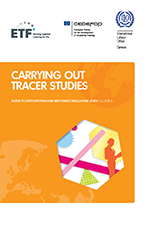Carrying out tracer studies - Guide to anticipating and matching skills and jobs Vol. 6
This guide, which is a part of the ETF, ILO and Cedefop series of guides on skills anticipation and matching, covers the development and carrying out of tracer studies and aims to contribute to the improvement of education in TVET and higher education through high-quality graduate surveys or tracer studies. The key objective of such studies is to identify the relevance of education/training for transition to a job and further vocational career in the first years after graduating. Many countries are experiencing growing demand for tracer studies due to the requirements of accreditation and quality management. Education institutions are often forced by law to implement regular tracer studies and there is demand from donor agencies for empirical evidence about the relevance of the education/training they sponsor. The main audience for this guide is those in education institutions who are going to organise and implement their own tracer studies (institutional tracer studies). It is also targeted at users in various categories: policy- and decision-makers; research centres and expert networks involved in carrying out tracer studies for clients; and associations and networks with interest in evidence offered by tracer studies. The reader will obtain detailed guidance on how to design a tracer study, develop a questionnaire and carry out data analysis, without being an expert in survey methodology.
Did you like this publication? If you would like to be notified when new content like this is published, subscribe to receive our email alerts.
